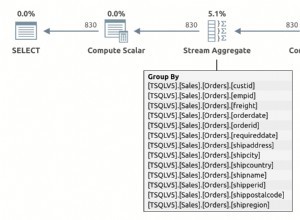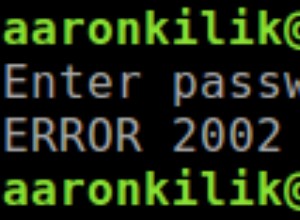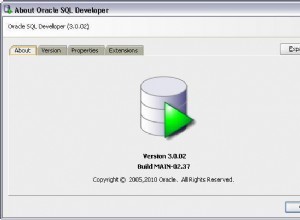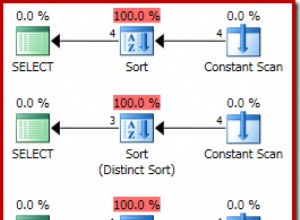Aquí está el ejemplo
EDITAR: Primero cree un nombre de base de datos supongamos dbname en MySql en wamp o en su servidor y cree una tabla llamada emp_info en el que se añaden dos campos id y nombre
Aquí, el escenario es insertar ID y NOMBRE del empleado desde EDITTEXT a la base de datos del servidor MYSQL
Las Variables Globales son
String name;
String id;
InputStream is=null;
String result=null;
String line=null;
int code;
Para código de actividad
import java.io.BufferedReader;
import java.io.InputStream;
import java.io.InputStreamReader;
import java.util.ArrayList;
import org.apache.http.HttpEntity;
import org.apache.http.HttpResponse;
import org.apache.http.NameValuePair;
import org.apache.http.client.HttpClient;
import org.apache.http.client.entity.UrlEncodedFormEntity;
import org.apache.http.client.methods.HttpPost;
import org.apache.http.impl.client.DefaultHttpClient;
import org.apache.http.message.BasicNameValuePair;
import org.json.JSONObject;
import android.app.Activity;
import android.os.Bundle;
import android.os.StrictMode;
import android.util.Log;
import android.view.View;
import android.widget.Button;
import android.widget.EditText;
import android.widget.Toast;
public class add extends Activity {
String name;
String id;
InputStream is=null;
String result=null;
String line=null;
int code;
String tobed = null;
@Override
public void onCreate(Bundle savedInstanceState) {
super.onCreate(savedInstanceState);
setContentView(R.layout.add);
StrictMode.ThreadPolicy policy = new StrictMode.ThreadPolicy.Builder().permitAll().build();
StrictMode.setThreadPolicy(policy);
final EditText e_id=(EditText) findViewById(R.id.editText1);
final EditText e_name=(EditText) findViewById(R.id.editText2);
Button insert=(Button) findViewById(R.id.button1);
insert.setOnClickListener(new View.OnClickListener() {
@Override
public void onClick(View v) {
// TODO Auto-generated method stub
id = e_id.getText().toString();
name = e_name.getText().toString();
insert();
}
});
}
}
Método de inserción de datos
public void insert()
{
ArrayList<NameValuePair> nameValuePairs = new ArrayList<NameValuePair>();
// put the values of id and name in that variable
nameValuePairs.add(new BasicNameValuePair("id",id));
nameValuePairs.add(new BasicNameValuePair("name",name));
try
{
HttpClient httpclient = new DefaultHttpClient();
// here is the php file
// for local use for example if you are using wamp just put the file in www/project folder
HttpPost httppost = new HttpPost("http://10.0.2.2/project/insert2.php");
// if the file is on server
HttpPost httppost = new HttpPost("http://example.com/insert2.php");
httppost.setEntity(new UrlEncodedFormEntity(nameValuePairs));
HttpResponse response = httpclient.execute(httppost);
HttpEntity entity = response.getEntity();
is = entity.getContent();
Log.e("pass 1", "connection success ");
}
catch(Exception e)
{
Log.e("Fail 1", e.toString());
Toast.makeText(getApplicationContext(), "Invalid IP Address",
Toast.LENGTH_LONG).show();
}
try
{
BufferedReader reader = new BufferedReader
(new InputStreamReader(is,"iso-8859-1"),8);
StringBuilder sb = new StringBuilder();
while ((line = reader.readLine()) != null)
{
sb.append(line + "\n");
}
is.close();
result = sb.toString();
Log.e("pass 2", "connection success ");
}
catch(Exception e)
{
Log.e("Fail 2", e.toString());
}
try
{
// get the result from php file
JSONObject json_data = new JSONObject(result);
code=(json_data.getInt("code"));
if(code==1)
{
Toast.makeText(getBaseContext(), "Inserted Successfully",
Toast.LENGTH_SHORT).show();
}
else
{
Toast.makeText(getBaseContext(), "Sorry, Try Again",
Toast.LENGTH_LONG).show();
}
}
catch(Exception e)
{
Log.e("Fail 3", e.toString());
Log.i("tagconvertstr", "["+result+"]");
}
}
aquí está el archivo insert2.php
<?php
// this variables is used for connecting to database and server
$host="yourhost";
$uname="username";
$pwd='pass';
$db="dbname";
// this is for connecting
$con = mysql_connect($host,$uname,$pwd) or die("connection failed");
mysql_select_db($db,$con) or die("db selection failed");
// getting id and name from the client
if(isset($_REQUEST)){
$id=$_REQUEST['id'];
$name=$_REQUEST['name'];}
$flag['code']=0;
// query for insertion
// table name emp_info and its fields are id and name
if($r=mysql_query("insert into emp_info values('$name','$id') ",$con))
{
// if query runs succesfully then set the flag to 1 that will be send to client app
$flag['code']=1;
echo"hi";
}
// send result to client that will be 1 or 0
print(json_encode($flag));
//close
mysql_close($con);
?>
Segunda edición:-
Para leer datos he hecho asytask
Aquí los datos se muestran en una vista de lista.
public class read extends Activity {
private String jsonResult;//
// use this if your file is on server
private String url = "http://exmaple.com/read.php";
// use this if you are locally using
// private String url = "http://10.0.2.2/project/read.php";
private ListView listView;
Context context;
String name;
String id;
InputStream is=null;
String result=null;
String line=null;
int code;
@Override
protected void onCreate(Bundle savedInstanceState) {
super.onCreate(savedInstanceState);
setContentView(R.layout.read);
StrictMode.ThreadPolicy policy = new StrictMode.ThreadPolicy.Builder().permitAll().build();
StrictMode.setThreadPolicy(policy);
context = this;
listView = (ListView) findViewById(R.id.listView1);
accessWebService();
}
método accessWebService
public void accessWebService() {
JsonReadTask task = new JsonReadTask();
task.execute(new String[] { url });
}
para la clase JsonReadTask
private class JsonReadTask extends AsyncTask<String, Void, String> {
// doInBackground Method will not interact with UI
@Override
protected String doInBackground(String... params) {
// the below code will be done in background
HttpClient httpclient = new DefaultHttpClient();
HttpPost httppost = new HttpPost(params[0]);
try {
HttpResponse response = httpclient.execute(httppost);
jsonResult = inputStreamToString(
response.getEntity().getContent()).toString();
}
catch (ClientProtocolException e) {
e.printStackTrace();
Log.e("Fail 12", e.toString());
} catch (IOException e) {
Log.e("Fail 22", e.toString());
e.printStackTrace();
}
return null;
}
private StringBuilder inputStreamToString(InputStream is) {
String rLine = "";
StringBuilder answer = new StringBuilder();
BufferedReader rd = new BufferedReader(new InputStreamReader(is));
try {
while ((rLine = rd.readLine()) != null) {
answer.append(rLine);
}
}
catch (IOException e) {
// e.printStackTrace();
Toast.makeText(getApplicationContext(),
"Error..." + e.toString(), Toast.LENGTH_LONG).show();
}
return answer;
}
// after the doInBackground Method is done the onPostExecute method will be called
@Override
protected void onPostExecute(String result) {
// here you can interact with UI
ListDrwaer();
}
}// end async task
Método ListDrawaer
// build hash set for list view
public void ListDrwaer() {
List<Map<String, String>> employeeList = new ArrayList<Map<String, String>>();
try {
// getting data from server
JSONObject jsonResponse = new JSONObject(jsonResult);
if(jsonResponse != null)
{
JSONArray jsonMainNode = jsonResponse.optJSONArray("emp_info");
// get total number of data in table
for (int i = 0; i < jsonMainNode.length(); i++) {
JSONObject jsonChildNode = jsonMainNode.getJSONObject(i);
String name = jsonChildNode.optString("name"); // here name is the table field
String number = jsonChildNode.optString("id"); // here id is the table field
String outPut = name + number ; // add two string to show in listview
employeeList.add(createEmployee("employees", outPut));
}
}
} catch (JSONException e) {
Toast.makeText(getApplicationContext(), "Error" + e.toString(),
Toast.LENGTH_SHORT).show();
}
SimpleAdapter simpleAdapter = new SimpleAdapter(this, employeeList,
android.R.layout.simple_list_item_1,
new String[] { "employees" }, new int[] { android.R.id.text1 });
listView.setAdapter(simpleAdapter);
}
private HashMap<String, String> createEmployee(String name, String number) {
HashMap<String, String> employeeNameNo = new HashMap<String, String>();
employeeNameNo.put(name, number);
return employeeNameNo;
}
}
y su código de archivo read.php
<?php
$host="localhost"; //replace with database hostname
$username="root"; //replace with database username
$password=""; //replace with database password
$db_name="dbname"; //replace with database name
$con=mysql_connect("$host", "$username", "$password")or die("cannot connect");
mysql_select_db("$db_name")or die("cannot select DB");
$sql = "select * from emp_info";
$result = mysql_query($sql);
$json = array();
if(mysql_num_rows($result)){
while($row=mysql_fetch_assoc($result)){
$json['emp_info'][]=$row;
}
}
mysql_close($con);
echo json_encode($json);
?>
y si desea verificar su conexión a Internet antes de usar esta inserción y leer, use este método ... es decir, coloque este método en la declaración if else
public boolean isOnline() {
ConnectivityManager cm =
(ConnectivityManager) getSystemService(Context.CONNECTIVITY_SERVICE);
NetworkInfo netInfo = cm.getActiveNetworkInfo();
if (netInfo != null && netInfo.isConnectedOrConnecting()) {
return true;
}
return false;
}
Para actualizar y eliminar, use el método de inserción para pasar los valores al servidor y simplemente cambie la consulta de insert2.php para actualizar unos como este
if($r=mysql_query("UPDATE emp_info SET employee_name = '$name' WHERE employee_name = '$id'",$con))
{
$flag['code']=1;
}
para borrar
if($r=mysql_query("DELETE FROM emp_info WHERE employee_name = '$name'",$con))
{
$flag['code']=1;
echo"hi";
}
Además, cuando haya aprendido esto, la siguiente tarea debe aprender a crear subprocesos y Asyntask para mejorarlo más, ya que trabajar en el subproceso principal no es bueno en Android. solo coloque este método de inserción en Asyntask como mencioné en el método de lectura para que la interfaz de usuario no se altere y todo lo relacionado con Internet se realice en segundo plano.
NOTA:
para la nueva versión de php, agregue esta línea después de <?php fragmento
error_reporting(E_ALL ^ E_DEPRECATED);




